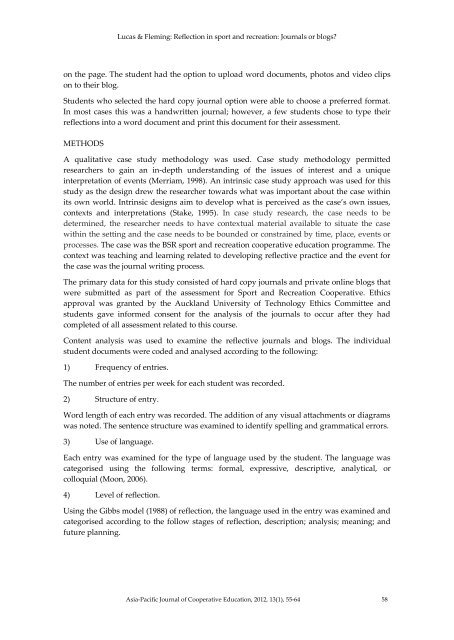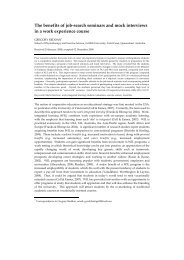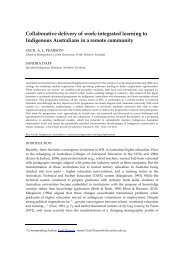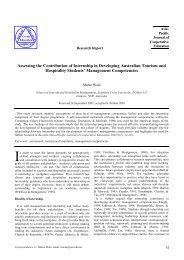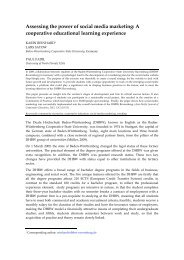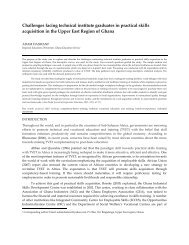Reflection in sport and recreation cooperative education: Journals or ...
Reflection in sport and recreation cooperative education: Journals or ...
Reflection in sport and recreation cooperative education: Journals or ...
You also want an ePaper? Increase the reach of your titles
YUMPU automatically turns print PDFs into web optimized ePapers that Google loves.
Lucas & Flem<strong>in</strong>g: <strong>Reflection</strong> <strong>in</strong> <strong>sp<strong>or</strong>t</strong> <strong>and</strong> <strong>recreation</strong>: <strong>Journals</strong> <strong>or</strong> blogs?<br />
on the page. The student had the option to upload w<strong>or</strong>d documents, photos <strong>and</strong> video clips<br />
on to their blog.<br />
Students who selected the hard copy journal option were able to choose a preferred f<strong>or</strong>mat.<br />
In most cases this was a h<strong>and</strong>written journal; however, a few students chose to type their<br />
reflections <strong>in</strong>to a w<strong>or</strong>d document <strong>and</strong> pr<strong>in</strong>t this document f<strong>or</strong> their assessment.<br />
METHODS<br />
A qualitative case study methodology was used. Case study methodology permitted<br />
researchers to ga<strong>in</strong> an <strong>in</strong>‐depth underst<strong>and</strong><strong>in</strong>g of the issues of <strong>in</strong>terest <strong>and</strong> a unique<br />
<strong>in</strong>terpretation of events (Merriam, 1998). An <strong>in</strong>tr<strong>in</strong>sic case study approach was used f<strong>or</strong> this<br />
study as the design drew the researcher towards what was imp<strong>or</strong>tant about the case with<strong>in</strong><br />
its own w<strong>or</strong>ld. Intr<strong>in</strong>sic designs aim to develop what is perceived as the case’s own issues,<br />
contexts <strong>and</strong> <strong>in</strong>terpretations (Stake, 1995). In case study research, the case needs to be<br />
determ<strong>in</strong>ed, the researcher needs to have contextual material available to situate the case<br />
with<strong>in</strong> the sett<strong>in</strong>g <strong>and</strong> the case needs to be bounded <strong>or</strong> constra<strong>in</strong>ed by time, place, events <strong>or</strong><br />
processes. The case was the BSR <strong>sp<strong>or</strong>t</strong> <strong>and</strong> <strong>recreation</strong> <strong>cooperative</strong> <strong>education</strong> programme. The<br />
context was teach<strong>in</strong>g <strong>and</strong> learn<strong>in</strong>g related to develop<strong>in</strong>g reflective practice <strong>and</strong> the event f<strong>or</strong><br />
the case was the journal writ<strong>in</strong>g process.<br />
The primary data f<strong>or</strong> this study consisted of hard copy journals <strong>and</strong> private onl<strong>in</strong>e blogs that<br />
were submitted as part of the assessment f<strong>or</strong> Sp<strong>or</strong>t <strong>and</strong> Recreation Cooperative. Ethics<br />
approval was granted by the Auckl<strong>and</strong> University of Technology Ethics Committee <strong>and</strong><br />
students gave <strong>in</strong>f<strong>or</strong>med consent f<strong>or</strong> the analysis of the journals to occur after they had<br />
completed of all assessment related to this course.<br />
Content analysis was used to exam<strong>in</strong>e the reflective journals <strong>and</strong> blogs. The <strong>in</strong>dividual<br />
student documents were coded <strong>and</strong> analysed acc<strong>or</strong>d<strong>in</strong>g to the follow<strong>in</strong>g:<br />
1) Frequency of entries.<br />
The number of entries per week f<strong>or</strong> each student was rec<strong>or</strong>ded.<br />
2) Structure of entry.<br />
W<strong>or</strong>d length of each entry was rec<strong>or</strong>ded. The addition of any visual attachments <strong>or</strong> diagrams<br />
was noted. The sentence structure was exam<strong>in</strong>ed to identify spell<strong>in</strong>g <strong>and</strong> grammatical err<strong>or</strong>s.<br />
3) Use of language.<br />
Each entry was exam<strong>in</strong>ed f<strong>or</strong> the type of language used by the student. The language was<br />
categ<strong>or</strong>ised us<strong>in</strong>g the follow<strong>in</strong>g terms: f<strong>or</strong>mal, expressive, descriptive, analytical, <strong>or</strong><br />
colloquial (Moon, 2006).<br />
4) Level of reflection.<br />
Us<strong>in</strong>g the Gibbs model (1988) of reflection, the language used <strong>in</strong> the entry was exam<strong>in</strong>ed <strong>and</strong><br />
categ<strong>or</strong>ised acc<strong>or</strong>d<strong>in</strong>g to the follow stages of reflection, description; analysis; mean<strong>in</strong>g; <strong>and</strong><br />
future plann<strong>in</strong>g.<br />
Asia-Pacific Journal of Cooperative Education, 2012, 13(1), 55-64 58


